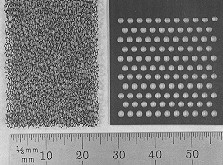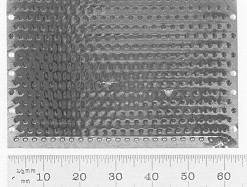Past Work: Contiguous Capillary Coating to Form Silicon Sheets
| This
multicrystalline Si ribbon growth process was originated in the late
1970's1,2. In this method, a porous or grid-like sheet of carbon
is passed through a Si melt to form a crystalline-Si coating that is contiguous
from the rear surface to the front surface. Because the substrate carries the
liquid coating along with it, very high speeds can be attained, with solidification taking place
some distance out of the melt reservoir where thermal profiles for heat removal can be
tailored. An example of a reticulated vitreous carbon substrate and a machined
graphite substrate are shown below, along with a Si-coated substrate. This
technique was later developed further at Seimens AEG in Munich, Germany, and
retitled the s-web method. |
 |
 |
______________________
1. T.F. Ciszek and G.H. Schwuttke,
"Inexpensive Silicon Sheets for Solar Cells," NASA Tech. Briefs,
Winter (1977) 432.
2. T.F.
Ciszek and J.L. Hurd, "Contiguous Capillary Coating of Silicon on Porous Carbon
Substrates," in: l4th IEEE Photovoltaic Specialist Conf.
Record, San Diego,
Calif. Jan. 7-l0, 1980, IEEE, New York, l980, pp. 397-399).
|